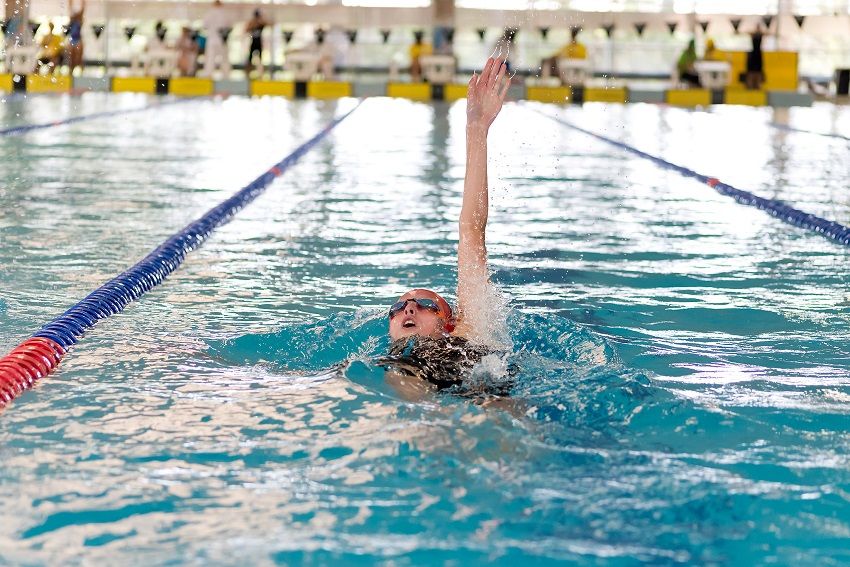Want to improve your feel for the water? Even help bullet-proof your shoulders from injury? Here’s why you should be doing more sculling during your swim practices.
It looks easy, and it kind of is.
Commonly swimmers cheat their way through it just to go faster and beat their teammates to the wall. Or not really give it the attention it deserves.
But when done slowly, and with focus, sculling is a Swiss Army knife for your swimming.
The Benefits of Sculling for Swimmers
Sure, it might not look like it does much, but under the surface, as your hands jet back and forth quickly, there is a lot happening.
Here are just some of the things that sculling can help do to help make you a better swimmer:
Improves feel for the water. It’s not easy to describe, but you know it when you feel it–that mythical feel for the water. During moments where we have more of it than usual, we feel great in the pool. We skim across the surface of the water, our pull feels extra pully, and for those few and fleeting moments, we’ve conquered the water. Sculling teaches you how to hold and grip the water efficiently.
Technique correction. Scull your way through the full pulling motion. From the catch, to having your hands perpendicular to your hips, all the way to the last part of the pulling motion. You’ll get a sense of where your “grip” of the water is strongest and where it is weakest. Anthony Ervin, sprint legend, spent a heap of time sculling in order to improve his catch when he first arrived at Cal in order to help him grab more water.
Early vertical forearm. For you freestyle and butterfly stroke specialists strap on a swim snorkel, put your face down, extend your arms above your head and scull with your elbow higher than your wrist, emulating the early vertical forearm you want during the first phase of the pulling motion. This is one of my favorite ways to hit reset on my freestyle when it’s feeling a little sloppier than usual.
Mega versatile. Want to spend more time working on your catch? Do some sculling where your hands would be initiating the catch. Not happy with the end of your pull? Spend some time back there doing some sculling. Left arm, right arm, palms, forearms–the sky is the limit. Use sculling strategically to precision strike the parts of your stroke that need some TLC.
Shoulder injury prevention. This one might sound a little strange, but sculling is one of my favorite ways to help injury-proof my shoulders. The way that I do this is pretty basic–with a snorkel on my fizz-ace, head down, I make sure that my shoulders are set back in their sockets, and that I have perfect posture in the water (this is absolutely key). Once my shoulders are “locked” back in their sockets, I like to do a quick sculling motion. At what angle my hands are sculling doesn’t really matter. But it’s gotta be quick–the quick hand movements will challenge your scapular stability, something that is essential to strong, swimmer’s shoulder-free, uh, shoulders.
Tips for Making the Most of Sculling:
1. Don’t forget your forearms. Our hands get a lot of attention when it comes to cranking up our pull, and deservedly so. But don’t forget those forearms. You don’t need to have Popeye-sized forearms to be able to use them for propulsion.
2. Mix it up with regular swimming. As with any kind of drill work, the whole point is to transfer over the lessons learned to your swimming so that you can improve yo’ swimming technique and efficiency. Alternate sculling and swimming to take that newfound feel for the water and apply it to your stroke. One of my favorite ways to incorporate any kind of drill work (and sculling, essentially, is a drill) is to sprinkle and splatter it within regular swimming. Doing 50’s as 25 scull, 25 swim build, for instance. Or doing 15m swim, 20m scull, 15m swim. You get the idea.
3. Use it to hit reset on your stroke and swim practice. We all have those swim workouts where we can’t seem to find our stroke. The water slips right through our fingers, and our usually gorgeous technique feels sloppy, hopeless or lost. Sculling takes things back to basics, reinvigorating your feel for the water and helping you rediscover your technique.
4. Use a snorkel. There are about a kajillion reasons to use a swimmer’s snorkel, from making a Darth Vader voice to helping balance out your stroke. Wearing a snorkel while sculling helps you stay focused on the movement of your hands instead of worrying about breathing or having your hips and head out of position.
5. Scull like you mean it. Sculling, by nature, isn’t fast. For the particularly competitive of competitive swimmers taking it slow and properly requires a little added discipline not to kick and cheat. The rewards–a more efficient and faster-feeling stroke–however, are totally worth it.
See Also:
- 9 Drills for a Faster Freestyle. Here are some of the top drills for freestylers from some of the top swimmers and coaches on the planet, including Olympians and NCAA coaches.
- Closed Fist Freestyle: How to Unleash a Monster Freestyle. Hands-down one of my favorite ways to improve feel for the water. Closed fist swimming helps you improve efficiency and clean up your technique.














